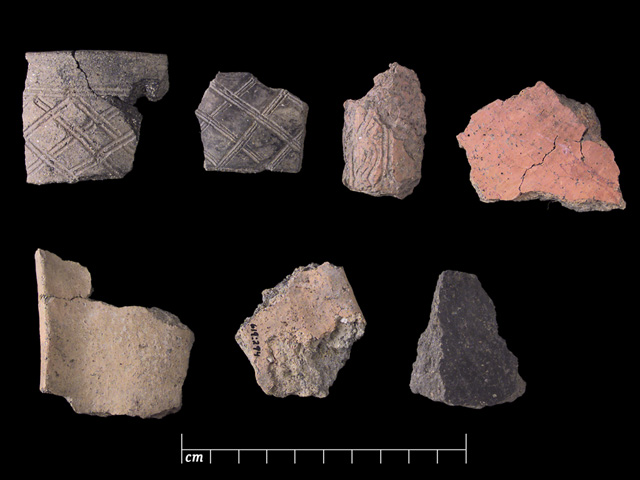 STUDIO PHOTOGRAPHS
STUDIO PHOTOGRAPHSIntroduction | Research | People | Tools
 STUDIO PHOTOGRAPHS
STUDIO PHOTOGRAPHS
FRAGMENTS OF CLAY POTS (motif 28)
Type: : Fragments of clay pots ornamented with nest patterns and reddish fragments without ornaments.
Use: Making, preserving and serving of food.
Site: Raisio, Ihala, Mulli abode.
Period: Viking Age / Crusade Age / Early Middle Ages.
Dating: 980-1220 A.D.
Photographer: Antti Huittinen.
Among the finds, the most common Iron-Age household utensils are pottery fragments. In the Iron Age, the clay pots were mostly humble, made of coarse clay and with few ornaments. They had a flat bottom and roundish walls. The flat-bottomed big vessels that look like crock became in use in the end of the Viking Age, ca. 10th and 11th century A.D.
Clay pots were used to make, preserve and serve food. Mulli clay pots are formed by hand. The lathe or potter's wheel was not introduced in western Finland until the 16th century. Besides clay pots, dishes of wood and bich-bark were commonly used but they have only seldom been preserved until our days.
In Mulli abode, reddish or brownish clay pots with few decorations were used as everyday dishes in which food was made and preserved. The clay pots which were burnt black and decorated were probably used as festive dishes.
Reconstructions of the processes used in the creation of ceramics were explored during workshops held in Raisio in 1997 by archaeologist Minna Hautio. In these workshops, using hypothetical materials, vessels were reconstructed and burnt.
Other pictures:
Other related topics:
Coordinates: All over the abode.
Introduction | Research | People | Tools